warning TOYOTA TACOMA 2013 Owners Manual (in English)
[x] Cancel search | Manufacturer: TOYOTA, Model Year: 2013, Model line: TACOMA, Model: TOYOTA TACOMA 2013Pages: 524, PDF Size: 10.96 MB
Page 2 of 524

TABLE OF CONTENTSIndex
2
1-1. Key informationKeys ..................................... 32
1-2. Opening, closing and locking the doors
Wireless remote control ....... 34
Side doors ............................ 37
Access doors (Access Cab models only) ....................... 41
Tailgate ................................ 42
1-3. Adjustable components (seats, mirrors, steering
wheel)
Front seats ........................... 47
Rear seats (Access Cab and Double Cab models) .......... 52
Head restraints ..................... 56
Seat belts ............................. 61
Steering wheel ..................... 67
Anti-glare inside rear view mirror .................................. 68
Outside rear view mirrors ..... 73
1-4. Opening and closing the windows
Power windows .................... 76
Back window (vehicles with sliding type) ........................ 78
1-5. Refueling Opening the fuel tank cap .... 79 1-6. Theft deterrent system
Engine immobilizer system ... 82
1-7. Safety information Correct driving posture ......... 85
SRS airbags ......................... 87
Front passenger occupant classification system ......... 101
Child restraint systems ....... 106
Installing child restraints ..... 110
2-1. Driving procedures Driving the vehicle .............. 130
Engine (ignition) switch....... 141
Automatic transmission ...... 144
Manual transmission........... 148
Turn signal lever ................. 151
Parking brake ..................... 152
Horn .................................... 154
2-2. Gauges and meters Gauges and meters ............ 155
Indicators and warning lights ................................. 158
2-3. Operating the lights and wipers
Headlight switch ................. 162
Fog light switch ................... 165
Windshield wipers and washer .............................. 166
1Before driving
2When driving
Page 5 of 524

1
2
3
4
5
6
7
5
5-2. Steps to take in an emergencyIf a warning light turns on or a warning buzzer
sounds... ........................... 403
If you have a flat tire............ 413
If the engine will not start .... 430
If the shift lever cannot be shifted from P (vehicles
with an automatic
transmission) .................... 431
If you lose your keys ........... 432
If the vehicle battery is discharged ........................ 433
If your vehicle overheats ..... 437
If the vehicle becomes stuck ................................. 440
If your vehicle has to be stopped in an
emergency ........................ 442
6-1. Specifications Maintenance data (fuel, oil level, etc.) ............ 446
Fuel information .................. 467
Tire information ................... 470
6-2. Customization Customizable features ........ 481
Items to initialize ................. 485 Reporting safety defects
for U.S. owners ................ 488
Seat belt instructions for Canadian owners
(in French) ........................ 489
SRS airbag instructions for Canadian owners
(in French) ........................ 491
Camper information ............ 502
Abbreviation list ......................... 510
Alphabetical index ..................... 512
What to do if... ........................... 521
6Vehicle specifications
7For owners
Index
Page 19 of 524
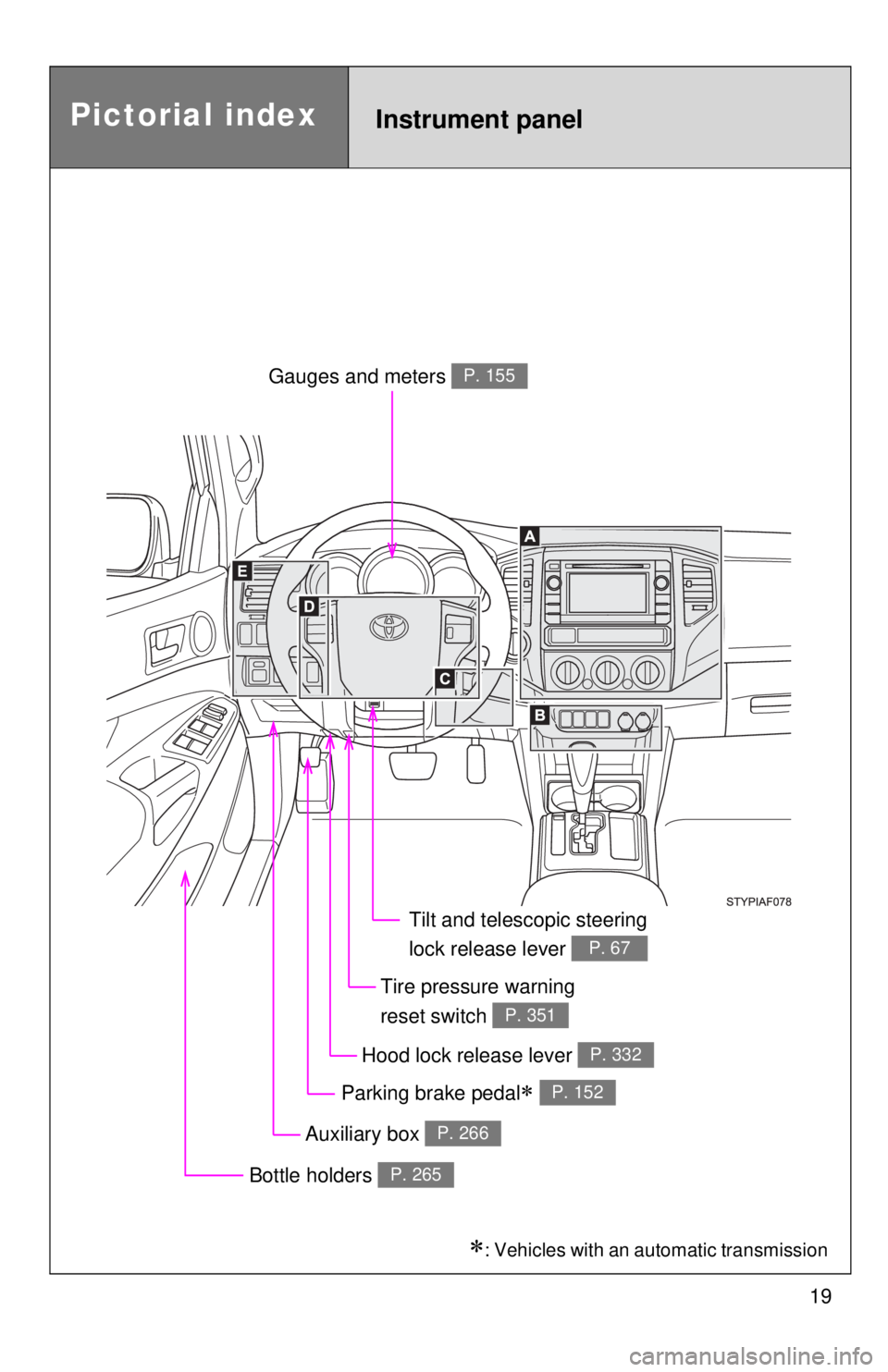
19
Pictorial indexInstrument panel
Auxiliary box P. 266
Gauges and meters P. 155
Hood lock release lever P. 332
Tilt and telescopic steering
lock release lever
P. 67
Bottle holders P. 265
Parking brake pedal P. 152
Tire pressure warning
reset switch
P. 351
: Vehicles with an automatic transmission
Page 30 of 524
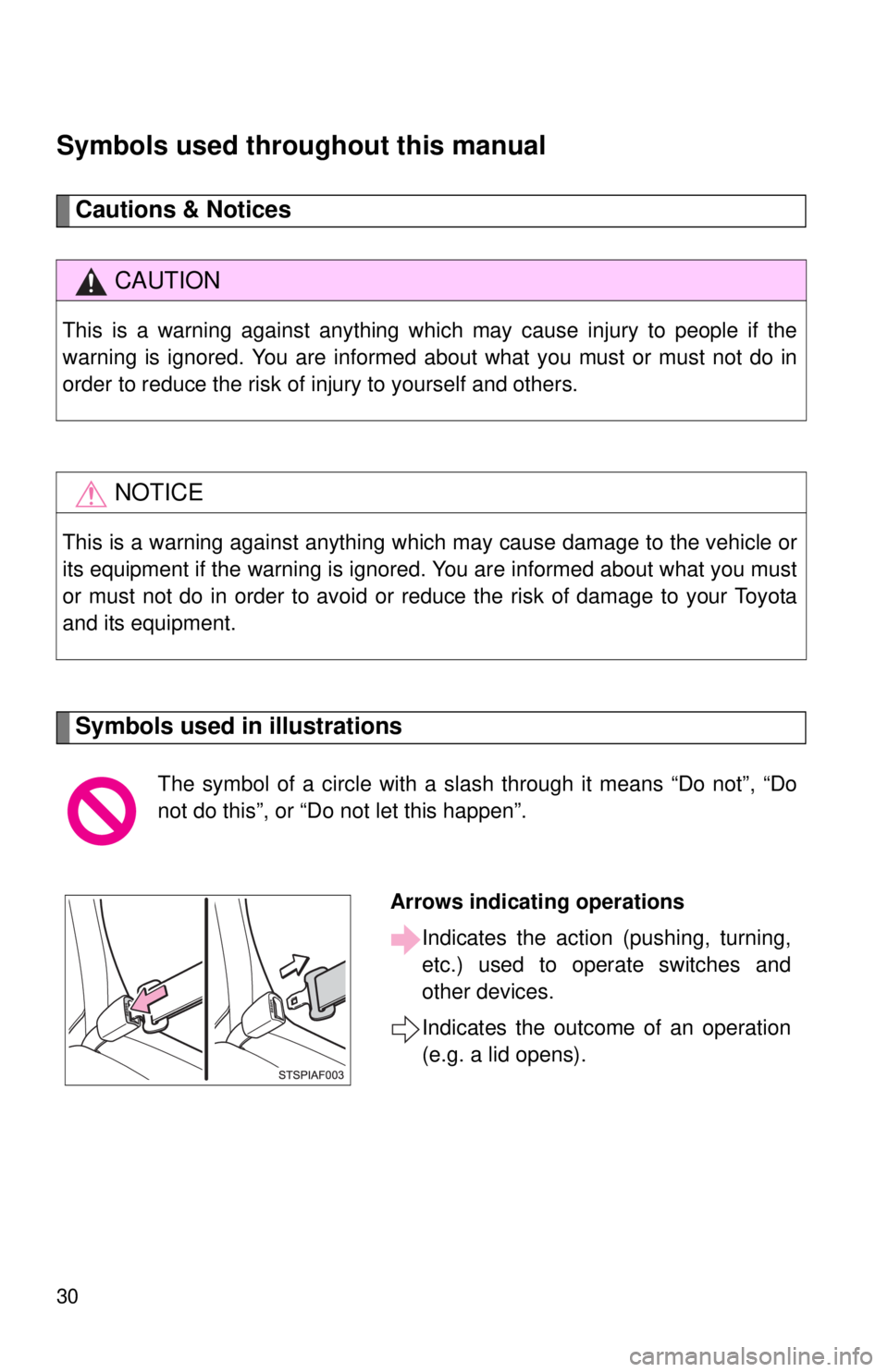
30
Symbols used throughout this manual
Cautions & Notices
Symbols used in illustrations
CAUTION
This is a warning against anything which may cause injury to people if the
warning is ignored. You are informed about what you must or must not do in
order to reduce the risk of injury to yourself and others.
NOTICE
This is a warning against anything which may cause damage to the vehicle or
its equipment if the warning is ignored. You are informed about what you must
or must not do in order to avoid or reduce the risk of damage to your Toyota
and its equipment.The symbol of a circle with a slash through it means “Do not”, “Do
not do this”, or “Do not let this happen”.
Arrows indicating operationsIndicates the action (pushing, turning,
etc.) used to operate switches and
other devices.
Indicates the outcome of an operation
(e.g. a lid opens).
Page 36 of 524

36 1-2. Opening, closing and locking the doors
■Certification for wireless remote control
MODEL/FCC IDs:
Transmitter: GQ43VT20T
Receiver: GQ4-34R
IC (Canada) IDs:
Transmitter: 1470A-1T
Receiver: 1470A-6R
MADE IN U.S.A.
This device complies with Part 15 of the FCC Rules and with RSS-210 of
Industry Canada. Operation is subject to the following two conditions:
(1) This device may not cause harmful interference, and (2) This device
must accept any interference received, including interference that may
cause undesired operation.
WARNING:
Changes or modifications not expressively approved by the party responsi-
ble for compliance could void the user’s authority to operate the equipment.
Page 65 of 524
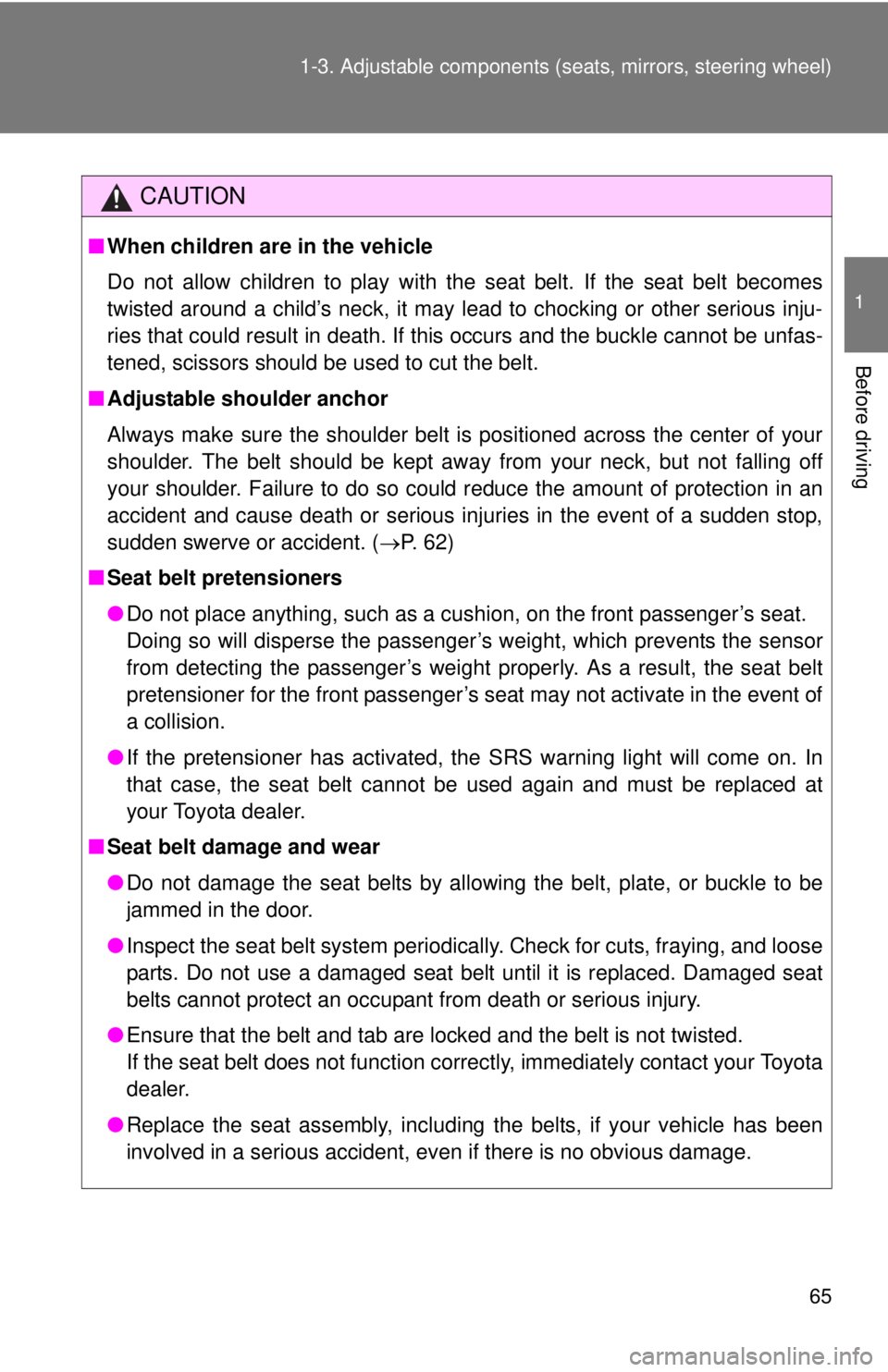
65
1-3. Adjustable components (s
eats, mirrors, steering wheel)
1
Before driving
CAUTION
■When children are in the vehicle
Do not allow children to play with the seat belt. If the seat belt becomes
twisted around a child’s neck, it may lead to chocking or other serious inju-
ries that could result in death. If this occurs and the buckle cannot be unfas-
tened, scissors should be used to cut the belt.
■ Adjustable shoulder anchor
Always make sure the shoulder belt is positioned across the center of your
shoulder. The belt should be kept away from your neck, but not falling off
your shoulder. Failure to do so could reduce the amount of protection in an
accident and cause death or serious injuries in the event of a sudden stop,
sudden swerve or accident. ( P. 62)
■ Seat belt pretensioners
●Do not place anything, such as a cushion, on the front passenger’s seat.
Doing so will disperse the passenger’s weight, which prevents the sensor
from detecting the passenger’s weight properly. As a result, the seat belt
pretensioner for the front passenger’s seat may not activate in the event of
a collision.
● If the pretensioner has activated, the SRS warning light will come on. In
that case, the seat belt cannot be used again and must be replaced at
your Toyota dealer.
■ Seat belt damage and wear
●Do not damage the seat belts by allowing the belt, plate, or buckle to be
jammed in the door.
● Inspect the seat belt system periodically. Check for cuts, fraying, and loose
parts. Do not use a damaged seat belt until it is replaced. Damaged seat
belts cannot protect an occupant from death or serious injury.
● Ensure that the belt and tab are locked and the belt is not twisted.
If the seat belt does not function correctly, immediately contact your Toyota
dealer.
● Replace the seat assembly, including the belts, if your vehicle has been
involved in a serious accident, even if there is no obvious damage.
Page 83 of 524

83
1-6. Theft deterrent system
1
Before driving
■
Certifications for the engine immobilizer system
For vehicles sold in U.S.A.
FCC ID: MOZRI-21BTY
This device complies with part 15 of the FCC Rules. Operation is subject to
the following two conditions: (1) This device may not cause harmful interfer-
ence, and (2) this device must accept any interference received, including
interference that may cause undesired operation.
FCC WARNING:
Changes or modifications not expressly approved by the party responsible
for compliance could void the user’s authority to operate the equipment.
For vehicles sold in Canada
Operation is subject to the following two conditions: (1) this device may not
cause interference, and (2) this device must accept any interference, includ-
ing interference that may cause undesired operation of the device.
Page 89 of 524
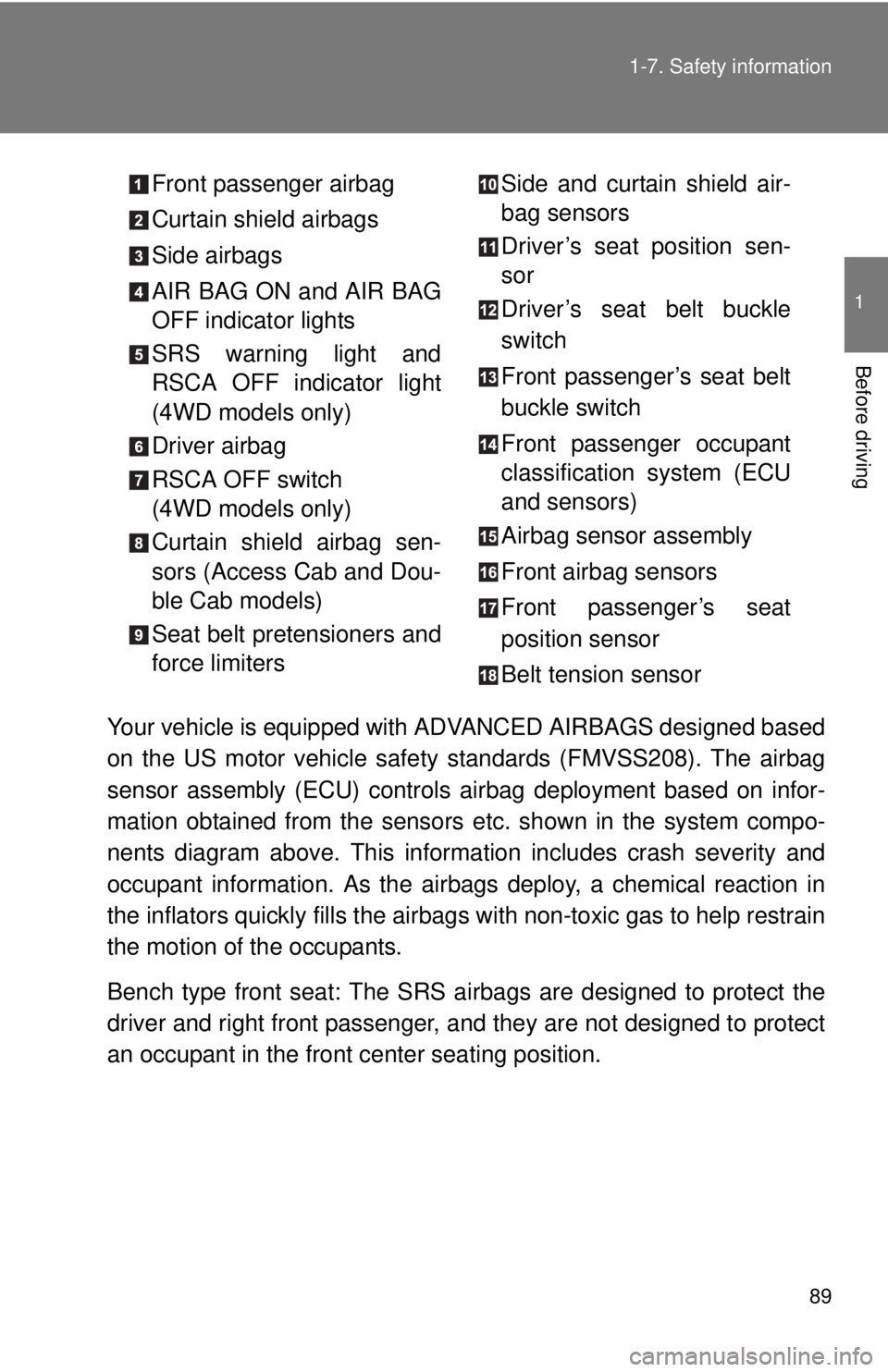
89
1-7. Safety information
1
Before driving
Your vehicle is equipped with
ADVANCED AIRBAGS designed based
on the US motor vehicle safety standards (FMVSS208). The airbag
sensor assembly (ECU) controls ai rbag deployment based on infor-
mation obtained from the sensors etc. shown in the system compo-
nents diagram above. This inform ation includes crash severity and
occupant information. As the air bags deploy, a chemical reaction in
the inflators quickly fills the airbag s with non-toxic gas to help restrain
the motion of the occupants.
Bench type front seat: The SRS ai rbags are designed to protect the
driver and right front passenger, and they are not designed to protect
an occupant in the front center seating position. Front passenger airbag
Curtain shield airbags
Side airbags
AIR BAG ON and AIR BAG
OFF indicator lights
SRS warning light and
RSCA OFF indicator light
(4WD models only)
Driver airbag
RSCA OFF switch
(4WD models only)
Curtain shield airbag sen-
sors (Access Cab and Dou-
ble Cab models)
Seat belt pretensioners and
force limiters
Side and curtain shield air-
bag sensors
Driver’s seat position sen-
sor
Driver’s seat belt buckle
switch
Front passenger’s seat belt
buckle switch
Front passenger occupant
classification system (ECU
and sensors)
Airbag sensor assembly
Front airbag sensors
Front passenger’s seat
position sensor
Belt tension sensor
Page 90 of 524

90 1-7. Safety information
■SRS warning light
This warning light system monitors the airbag sensor assembly, front airbag
sensors, side and curtain shield airbag sensor assemblies, curtain shield air-
bag sensor assemblies (Access Cab and Double cab models), driver’s seat
position sensor, driver’s seat belt buckle switch, front passenger occupant
classification system (ECU and sensors), AIR BAG ON and AIR BAG OFF
indicator lights, front passenger’s seat position sensor (Bench type seat),
front passenger’s seat belt buckle switch, front seat belt pretensioner
assemblies, belt tension sensor (Bench type seat), RSCA OFF indicator light
(4WD models only), airbags, interconnecting wiring and power sources.
(P. 404)
■ If the SRS airbags deploy (inflate)
●Bruising and slight abrasions may result from contact with a deploying
(inflating) SRS airbag.
● A loud noise and white powder will be emitted.
● Parts of the airbag module (steering wheel hub, airbag cover and inflator)
as well as the front seats, and parts of the front and rear pillars and roof
side rail, may be hot for several minutes. The airbag itself may also be
hot.
● The front windshield may crack.
■ Operating conditions (front airbags)
● The SRS front airbag will deploy in the event of an impact that exceeds
the set threshold level (the level of force corresponding to an approxi-
mately 12-18 mph [20-30 km/h] frontal collision with a fixed wall that does
not move or deform).
However, this threshold velocity will be considerably higher if the vehicle
strikes an object, such as a parked vehicle or sign pole, which can move or
deform on impact, or if the vehicle is involved in an underride collision (e.g.
a collision in which the front of the vehicle “underrides”, or goes under, the
bed of a truck, etc.).
Page 101 of 524
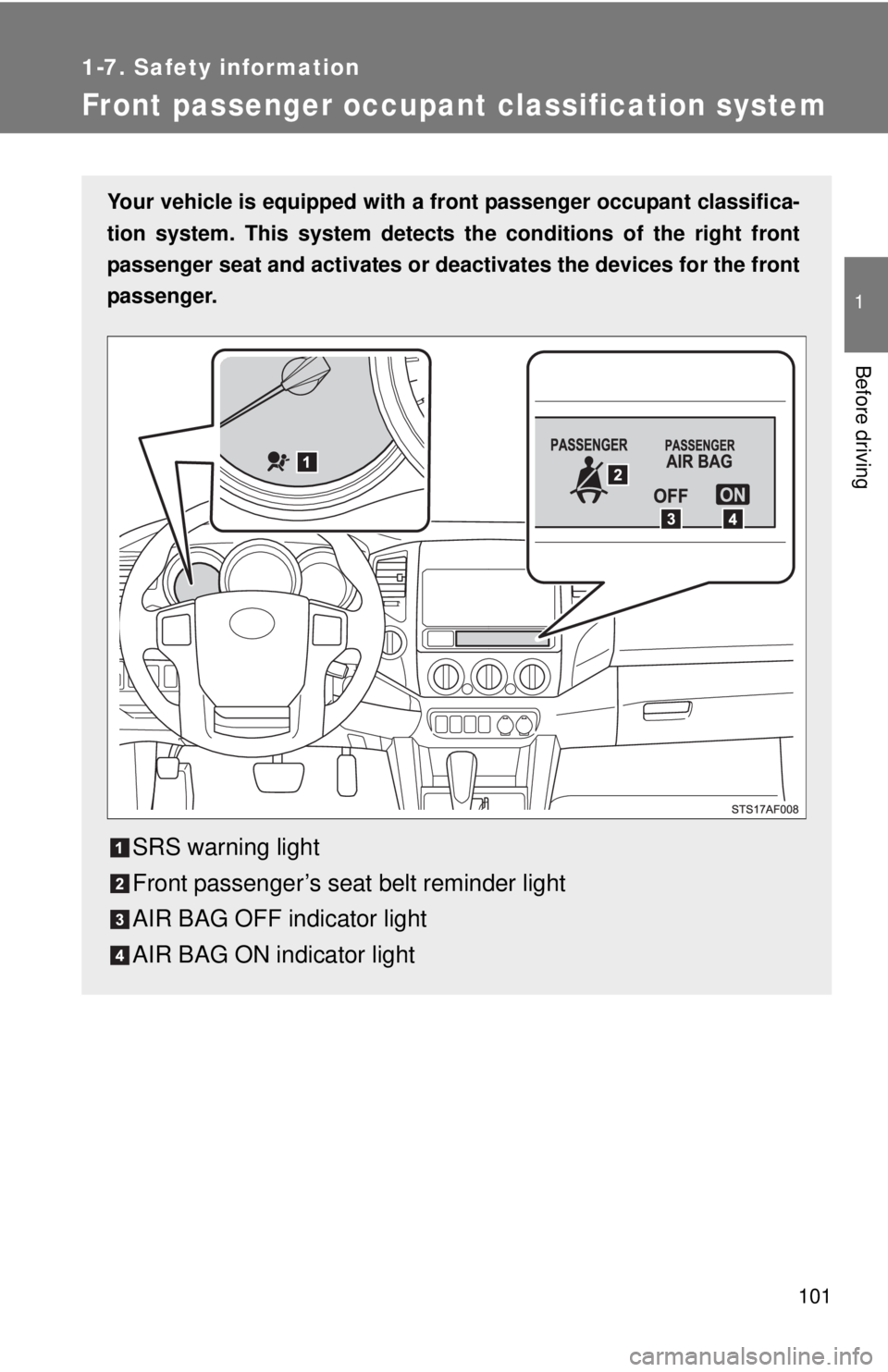
101
1
1-7. Safety information
Before driving
Front passenger occupant classification system
Your vehicle is equipped with a front passenger occupant classifica-
tion system. This system detects the conditions of the right front
passenger seat and activates or deactivates the devices for the front
passenger.
SRS warning light
Front passenger’s seat belt reminder light
AIR BAG OFF indicator light
AIR BAG ON indicator light